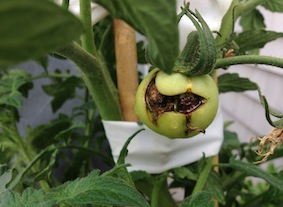+86- 111****
Boluo county dragon Lotus Lake Village Town Industrial Park, China

For this installment of Just Veggies, I find myself nowhere near my community garden plot.
I’m blissfully vacationing. However, I’m not without vegetables nearby. I’m staying at a friend’s seaside home on Cape Cod, and she has decked out the patio with a nice assortment of herbs and tomatoes planted in containers and window boxes.
Now, my friend was very proud, indeed, that a tomato has presented itself in early June. But as you can see from the photo, it’s not all that pretty. It has a vicious crack. What could have caused this?
There are many reasons why tomatoes crack. For this particular tomato, there may be two causes: lack of water and calcium deficiency.
Lack of water and inconsistent watering (lots followed by very little) is never a good thing. Water is more than just water—it’s how nutrients travel from the soil and up the plant. Lack of water means the plant isn’t carrying nutrients to areas that need it. In this case, the developing tomato has experienced a lack of calcium. This type of cracking is indicative of calcium deficiency.
The question is, was this cracking caused by inconsistent watering alone? Or was there also a lack of calcium in the potting soil? It’s hard to tell unless we do a soil test. And if it were a garden bed, maybe I’d go to that expense. But for now, we’ll assume we need to address both a lack of water and a lack of calcium in the soil.
My recommendation is to purchase a fertilizer or soil amendment specially formulated for tomatoes. Espoma has a natural fertilizer called Tomato-Tone. If you find a crack in your tomato, it’s not too late for the rest of the tomatoes on the plant. Just work the fertilizer into the soil according to package directions.
There are other types of cracking, as well, such as growth cracks and splitting from too much water. Those we will address in the future. But for now, stay on top of that watering and make it as consistent as you can.